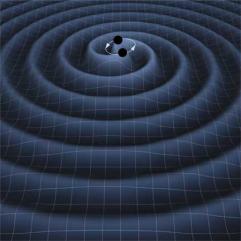Coalescence of intermediate-mass black holes: Implications for GW Astronomy

- An artist's representation of the burst of gravitational waves resulting from the collision of a colliding pair of black holes.

- © LIGO Scientific Collaboration (LSC) / NASA
Dr. Pau Amaro-Seoane
(AEI Potsdam-Golm)
Freitag/Friday, 2014-12-05, 14:00 c.t., EW 561
Eugene-Paul-Wigner Gebäude, Hardenbergstr. 36, 10623 Berlin
Zusammenfassung/Abstract:
Observations suggest that star clusters often form in binaries or larger bound groups. Therefore, mergers between two clusters are likely to occur. If these clusters both harbour an intermediate-mass black hole (IMBH; ~100-10,000 M$_\odot$) in their center, they can become a strong source of gravitational waves when the black holes merge with each other.
The prospect of the detection and characterization of an IMBH binary has very good chances in lower frequency gravitational-wave (GW) astrophysics using ground-based detectors such as the Laser Interferometer Gravitational-Wave Observatory (LIGO), Virgo, eLISA and the future Einstein Telescope (ET). I will discuss the formation of these sources, their event rates and the consequences for both theoretical astrophysics and GR, in particular for the Advanced detectors LIGO and VIRGO. Additionally, I will show how the dynamics of IMBH binaries can be related to the formation of Ultra Compact Dwarf Galaxies.

